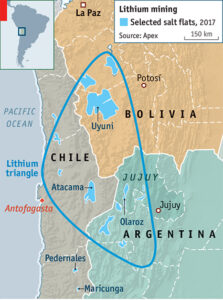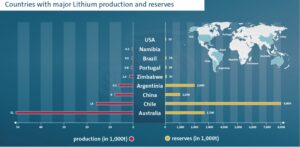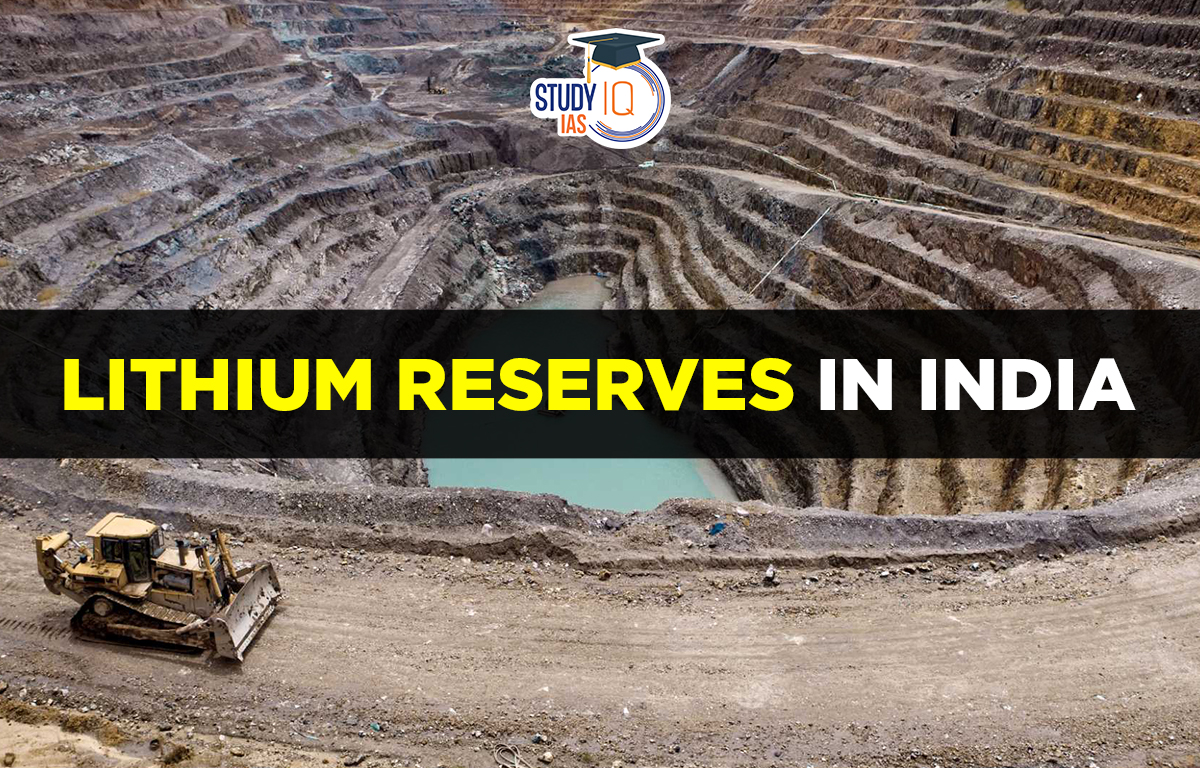Table of Contents
India is in talks with Chile and Bolivia for tapping into lithium mining and sourcing the Lithium mineral that remains the cornerstone for the country’s switch to green mobility.
Lithium Reserves in India
Lithium which is also called “white gold” because it is so important for rechargeable batteries, is a soft, shiny metal. Recently, the Geological Survey of India (GSI) found 5.9 million tonnes of lithium in the Salal-Haimana area of Reasi district in Jammu and Kashmir, making India one of the top 10 countries with lithium reserves.
Properties of Lithium
The chemical symbol for lithium is “Li,” and its atomic number is 3. The name comes from the Greek word “lithos,” which means stone. Lithium is a soft, shiny white-silver metal and is the lightest metal. It can dissolve in water and is found in ocean water as an ion.
Uses of Lithium
- Lithium is separated from a mix of lithium chloride and potassium chloride.
- It helps treat mental illnesses, including bipolar disorder.
- Lithium salts act as mood stabilizers and antidepressants.
- It is used in many industrial products, especially in lithium metal and lithium-ion batteries.
- Lithium is well-known for its importance in energy storage technology.
What is Lithium Triangle?
The Lithium Triangle is a region in the Andes that includes parts of Argentina, Bolivia, and Chile, and it has a lot of lithium deposits. Most of the lithium is found in the salt flats in the Atacama Desert and nearby dry areas. This region is home to the largest lithium deposits in the world, which are important for making batteries for electric vehicles, cell phones, and other electronics. It’s estimated that the Lithium Triangle holds about 54% to 58% of the world’s lithium resources.
Lithium Triangle Countries
- Bolivia has the world’s largest lithium reserves.
- Argentina has the world’s second-largest lithium reserve.
- Chili has the world’s third-largest lithium reserve.

The USA has the fourth-largest lithium deposits in the world at 6.8 million tonnes, it does not produce much lithium. Australia has the fifth-largest reserves at 6.3 million tonnes, but it was the biggest lithium producer in the world in 2019. China has 4.5 million tonnes of lithium reserves, making it sixth on the list. In 2019, China produced 7500 tonnes of lithium, which put it in third place globally.
Significance of Lithium Triangle
- Lithium is important for developing clean energy technologies and fighting climate change.
- It is needed to make rechargeable lithium-ion batteries, which power electric vehicles and store energy from renewable sources.
- Extracting lithium efficiently and sustainably from this region is important for moving toward a more sustainable energy future.
Jammu & Kashmir Lithium Reserve
One of the largest Lithium Resources in the world, the recently discovered lithium deposit is believed to be 5.9 million tonnes and is located in the Salal-Haimana area in the Reasi District of Jammu & Kashmir (UT) according to the Geological Survey of India (GSI). Lithium reserves in a tiny area of land studied in Southern Karnataka’s Mandya district were previously assessed to be 14,100 tonnes by scientists at the Atomic Minerals Directorate (under India’s Atomic Energy Commission).
Gujarat will host India’s first lithium factory in 2021, with Manikaran Power Limited investing Rs 1000 crore to build the refinery. The ore of lithium will be used in the refinery to make the basic components of batteries. TATA is developing Li-ion batteries that are entirely built in India. These batteries are produced by the Indian Space Research Organisation (ISRO), however, their availability and application are currently constrained.
A Memorandum of Agreement for Li-battery operation and technology transfer to India was inked in 2018 between RAASI Solar Power Private Limited and the Central Electro Chemical Research Institute in Tamil Nadu.
Lithium Reserves in World Map
Few countries such as Chile, Australia, Argentina, China, US in the world have the largest lithium reserves, regardless of their stage of development.

Lithium Reserve in India UPSC
Due to its widespread use in products essential to modern living, lithium has been termed “white gold.” Lithium demand and supply cannot even somewhat keep up. The International Energy Agency forecasts that a lithium shortage could happen by 2025.
India now imports a number of minerals to meet its demand, including lithium, nickel, and cobalt. As the world strives to wean itself off its reliance on China for crucial battery materials, India is taking ambitious steps to establish itself as a rival in the supply chain for electric vehicles. Only a small portion of the raw ingredients needed to satisfy domestic demand for lithium-ion batteries are available in India.


 LIGO Detects Most Massive Black Hole Mer...
LIGO Detects Most Massive Black Hole Mer...
 Why Is Earth Spinning Faster? Causes and...
Why Is Earth Spinning Faster? Causes and...
 Places in News for UPSC 2025 for Prelims...
Places in News for UPSC 2025 for Prelims...





















